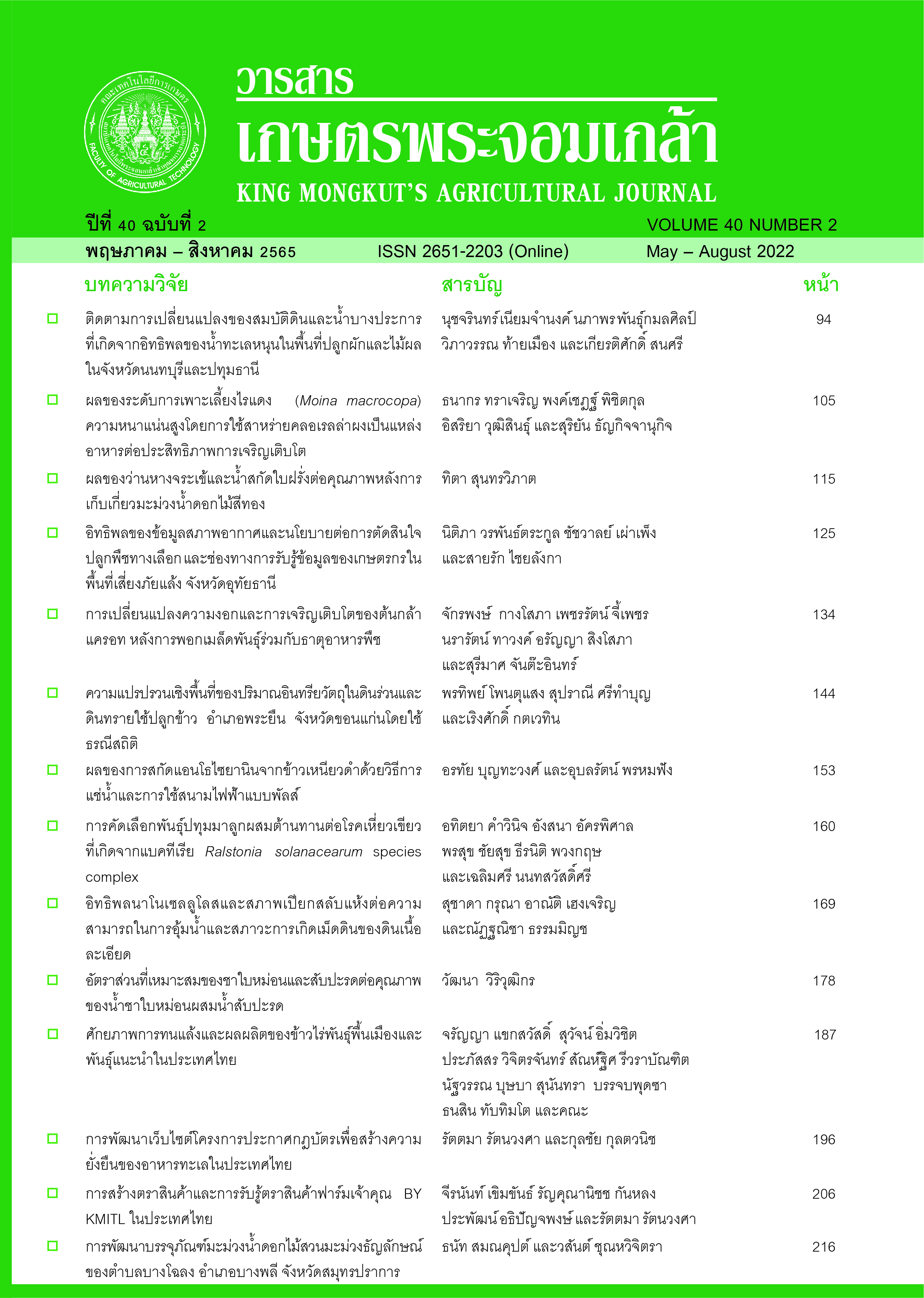ผลของว่านหางจระเข้และน้ำสกัดใบฝรั่งต่อคุณภาพหลังการเก็บเกี่ยวมะม่วงน้ำดอกไม้สีทอง
Main Article Content
บทคัดย่อ
มะม่วงน้ำดอกไม้สีทองจัดว่าเป็นมะม่วงที่มีความสำคัญต่อการส่งออกของประเทศไทย แต่คุณภาพของผลผลิตส่วนใหญ่จะลดลงอย่างรวดเร็วหลังกระบวนการเก็บเกี่ยว โดยเฉพาะอย่างยิ่งหากกระบวนการจัดการหลังการเก็บเกี่ยวและการเก็บรักษาที่ไม่เหมาะสมจะส่งผลให้มะม่วงน้ำดอกไม้สีทองไม่ได้คุณภาพและมาตรฐานการจำหน่ายเพื่อการส่งออก ดังนั้นการวิจัยเพื่อทดสอบผลของสารเคลือบผิวมะม่วงจากว่านหางจระเข้ (0, 30 และ 60%) และสารสกัดใบฝรั่ง (0, 30 และ 60%) และการผสมกันระหว่างว่านห่างจระเข้ 15% + สารสกัดใบฝรั่งที่ความเข้มข้น 15% และว่านหางจระเข้ 30% + สารสกัดใบฝรั่งที่ความเข้มข้น 30% ตามลำดับ เก็บรักษามะม่วงที่อุณหภูมิห้อง (30±2)ºC ความชื้นสัมพัทธ์ (65±2%) บันทึกผลจากค่าการสูญเสียน้ำหนัก ความแน่นเนื้อ ปริมาณกรดที่ไทเทรตได้ ปริมาณของแข็งที่ละลายน้ำได้ ค่าความเป็นกรด-ด่าง ปริมาณวิตามินซี การเปลี่ยนแปลงของสีผิว และการประเมินคุณภาพทางประสาทสัมผัส เปรียบเทียบกับกลุ่มควบคุมคือไม่ได้เคลือบผิว พบว่ามะม่วงน้ำดอกไม้สีทองที่เคลือบผิวด้วยสารเคลือบผิวว่านหางจระเข้ 60% และสารเคลือบผิวว่านหางจระเข้ 30% + สารสกัดใบฝรั่ง 30% ช่วยชะลอกระบวนการเปลี่ยนแปลงสีผิวของผล ลดการสูญเสียน้ำหนัก ปริมาณวิตามินซี การเปลี่ยนแปลงลักษณะเนื้อสัมผัส และช่วยยืดอายุการเก็บรักษาของมะม่วงน้ำดอกไม้สีทองได้ดีที่สุด โดยผู้บริโภคยอมรับได้ที่ 8 วัน เมื่อเทียบกับชุดควบคุมได้ 4 วัน (P<0.05) ดังนั้นการใช้สารเคลือบผิวทั้งสองชนิดนี้ผสมกันจึงอาจเป็นอีกแนวทางหนึ่งในการจัดการหลังการเก็บเกี่ยวและการเก็บรักษาคุณภาพมะม่วงน้ำดอกไม้สีทองในการเคลือบผิวผลผลิตอินทรีย์เพื่อการส่งออกในอนาคต
Article Details

อนุญาตภายใต้เงื่อนไข Creative Commons Attribution-NonCommercial-NoDerivatives 4.0 International License.
วารสารเกษตรพระจอมเกล้า
เอกสารอ้างอิง
ดนัย บุณยเกียรติ. 2540. สรีรวิทยาหลังการเก็บเกี่ยวพืชสวน. เชียงใหม่: คณะเกษตรศาสตร์ มหาวิทยาลัยเชียงใหม่.
จริงแท้ ศิริพานิช. 2549. ชีววิทยาหลังการเก็บเกี่ยวและการวายของพืช (Postharvest Biology and Plant Senescence). กรุงเทพฯ:
ภาควิชาพืชสวน คณะเกษตร วิทยาเขตกำแพงแสน มหาวิทยาลัยเกษตรศาสตร์ นครปฐม.
Abdelrahim, S. I., Almagboul, A. Z., Omer, M. E. A., and Elegami, A. 2002. Antimicrobial activity of Psidium guajava L. Fitoterapia
(7): 713-715.
Acosta, R. M., Neito, A. D., Mena, N. G. V., Vaquera, H. H., Teliz, O. D., and Nieto, A. R. 2000. Effect of post-harvest temperature on
the development of internal darkening in mango fruit (Mangifera indica L.) cv. Haden and their quality. Acta Horticulture 509:
-412.
Amarante, C., and Bank, N. H. 2001. Postharvest physiology and quality of coated fruits and vegetables. Horticultural Reviews 26: 161-
AOAC. 1984. Methods of Analysis. 14th ed. Washington, DC: Association of Official Analytical Chemists.
Baldwin, E. A. 1994. Edible coating for fresh fruits and vegetables: past present, and future. In Edible coatings and films to improve
food quality, Krochta, J. M., Baldwin, E. A., and Nisperos-Carriedo, M. O. ed. pp. 25-64. Lancaster, Basel: Technomic
Publishing Inc.
Baldwin, E. A., Nisperos, M. O., Hagenmaier, R. H., and Baker, R. A. 1997. Use of lipids inedible coatings for food products. Food
Technology 51: 56-62.
Bautista-Banos, S., Hernandez-Lauzardo, A. N., Velazquez-del Valle, M. G., Hernandez-Lopez, M., Barka, E. A., Bosquez-Molina, E.,
and Wilson, C. L. 2006. Chitosan as a potential natural compound to control pre and postharvest diseases of horticulture
commodities. Crop Protection 25: 108-118.
Chang, W. S., AfsahHejri, L., Rukayadi, Y., Khatib, A., Lye, Y. L., Loo, Y. Y., and Tang, J. Y. H. 2013. Quantification of Escherichia coli
O157: H7 in organic vegetables and chickens. International Food Research Journal 20(2): 1023-1029.
Chien, P. J., Sheu, F., and Lin, H. R. 2007. Coating citrus (Murcott tangor) fruit with low molecular weight chitosan increase postharvest
quality and shelf life. Food Chemistry 100: 1120-1164.
Coseteng, M. Y., and Lee, C. Y. 1978. Changes in apple polyphenoloxidase and polyphenol concentrations in relation to degree of
browning. Journal of Food and Science 52(4): 985-989.
Dodd, J. C., Prusky, D., and Jeffries, P. 1977. Fruit diseases. In The mango: Botany, production and uses, Litz, R. E., ed. pp.257-280.
UK: CAB International.
Eshun, K., and He, Q. 2005. Aloe vera: a valuable ingredient for the food, pharmaceutical and cosmetic industries: a review. Critical
Reviews in Food Science and Nutrition 44: 91-96.
Fallik, E., Yavin, S., Shalom A., Olga, L., Esther, B., and Uzi, R. 2005. External, internal and sensory traits in Galia-type melon
treated with different waxes. Postharvest Biology and Technology 36: 69-75.
Ghulam, K., Hafiz, T. A., Intazarr, A., and Muhammad, W. 2019. Aloe vera gel enriched with garlic essential oil effectively controls
anthracnose and maintains postharvest quality of banana fruit during storage. Horticulture, Environment, and Biotechnology
: 659-669.
Hassanpour, H. 2015. Effect of Aloe vera gel coating on antioxidant capacity, antioxidant enzyme activities and decay in raspberry
fruit. LWT-Food Science Technology 83: 54-57.
Hagenmaier, R. D. 2002. The flavor of mandarin hybrids with different coatings. Postharvest Biology and Technology 24: 79-87.
Islam, T., Afrin, N., Parvin, S., Dana, N. H., Rahman, K. S., Zaman, W., and Islam, M. N. 2018. The impact of chitosan and guava leaf
extract as preservative to extend the shelf-life of fruits. International Food Research Journal 25(5): 2056-2062.
Joseph, B. and Priya, M. 2011. Review on nutritional, medicinal and pharmacological properties of guava (Psidium guajava Linn.).
International Journal of Pharma and Bio Science 2(1): 53-69.
Liu, H., Song, L., You, Y., Li, Y., Duan, X., Jiang, Y., and Lu, W. 2011. Cold storage duration affects litchi fruit quality, membrane
permeability, enzyme activities and energy charge during shelf time at ambient temperature. Postharvest Biology Technology
: 24-30.
Mendy, T. K., Misran, A., Mahmud, T. M. M., and Ismail, S. I. 2019. Application of Aloe vera coating delays ripening and extend the
shelf life of papaya fruit. Scientia Horticulturae 246: 769-776.
Mitra, S. K., and Baldwin, E. A. 1977. Mango. In Postharvest physiology and storage of tropical and subtropical fruits, Mitra, S. K. ed.
pp. 85-122. New York: CAB International.
Ochiki, S., Gesimba, M. R., and Wolukau, J. N. 2015. Effect of Aloe vera gel coating on postharvest quality and shelf life of mango
(Mangifera indica L.) fruits Var. ‘Ngowe’. Journal of Horticulture and Forestry 7(1): 1-7.
Petracek, P. D., Dou, H., and Pao, S. 1998. The influence of applied waxes on postharvest physiological behavior and pitting of
grapefruit. Postharvest Biology and Technology 14: 99-1006.
Pornchan, J., Teerada, W., Pranee, R., and Kanogwan, S. 2016. Effect of molecular weights of chitosan coating on postharvest quality
and physicochemical characteristics of mango fruit. Food Science and Technology 73: 28-36.
Ranganna, S. 1997. Manual of Analysis of Fruit and Vegetables Products. New Delhi: Tats McGraw-Hill Publishing Company Limited.
Rasouli, M., Saba, M. K., and Ramezanian, A. 2019. Inhibitory effect of salicylic acid and Aloe vera gel edible coating on microbial
load and chilling injury of orange fruit. Scientia Horticulturae 247: 27-34.
Sirijariyawat, A., and Charoenrein, S. 2014. Texture and pectin content of four frozen fruits treated with calcium. Journal of Food
Process 38: 1346-1355 .
Vieira, J. M., Flores-López, M. L., RodrÍquez, D. J., Sousa, M. C., Vicente, A. A., and Martins, J. T. 2016. Effect of chitosan–Aloe
vera coating on postharvest quality of blueberry (Vaccinium corymbosum) fruit. Postharvest Biology Technology 116: 88-97.


